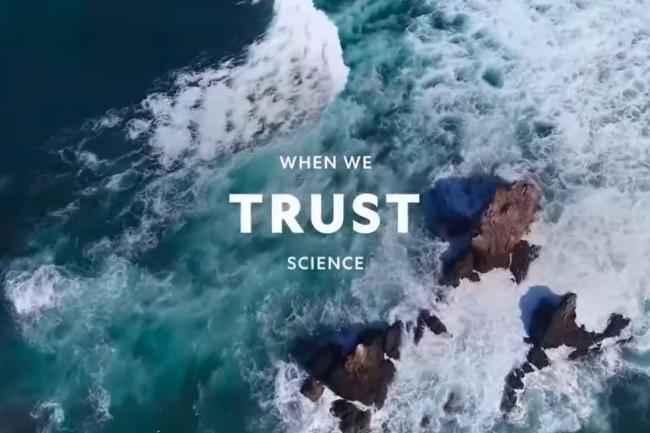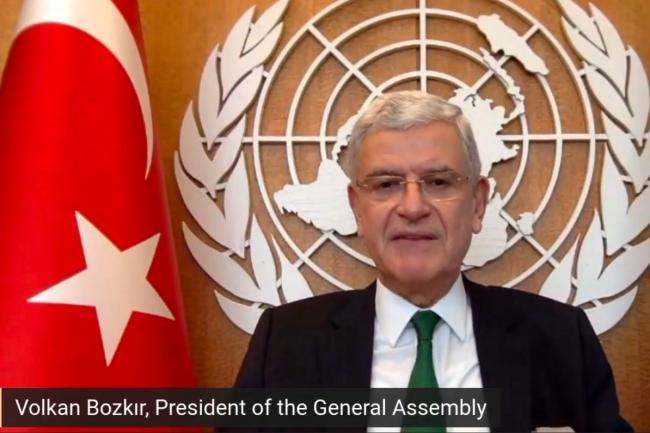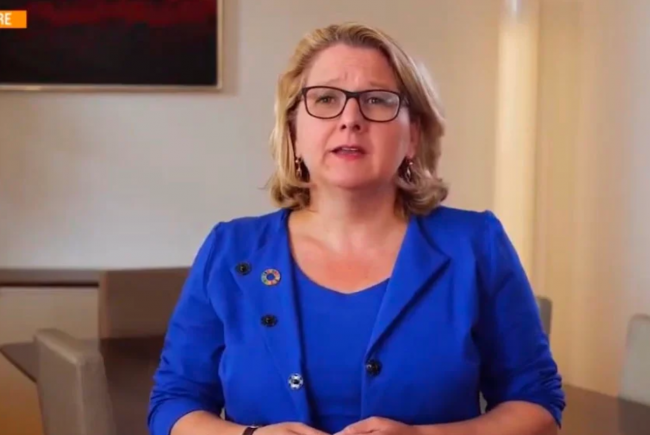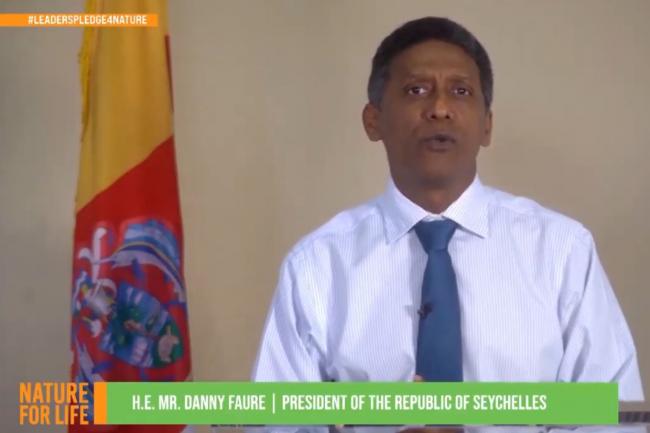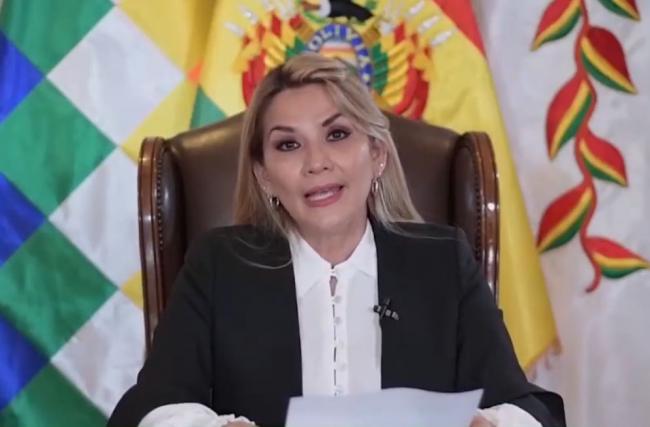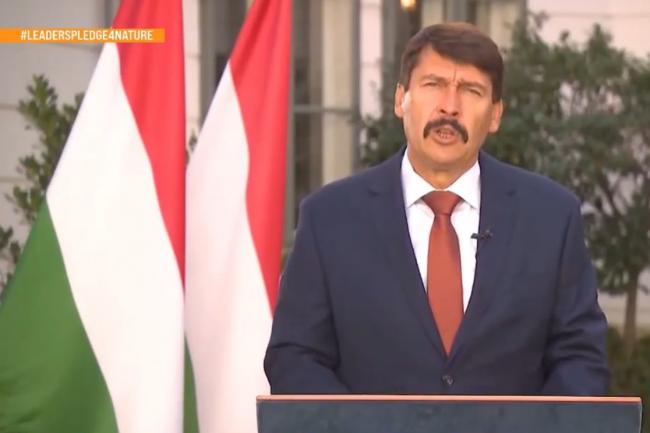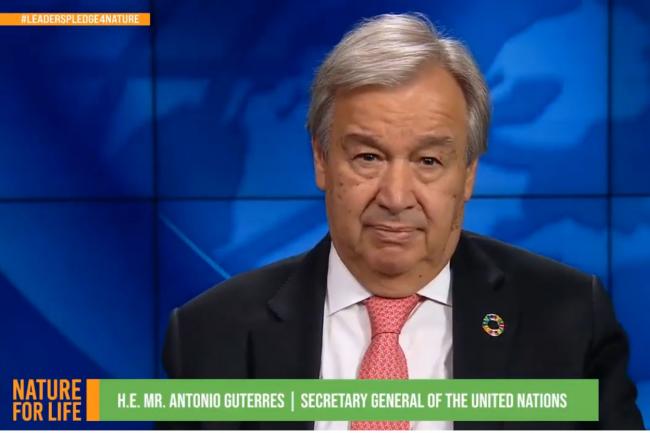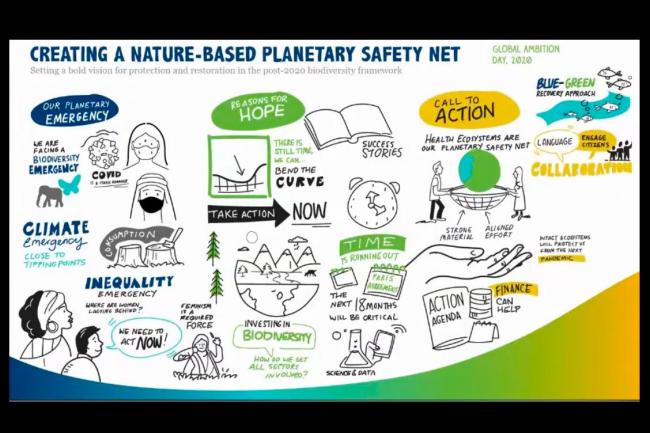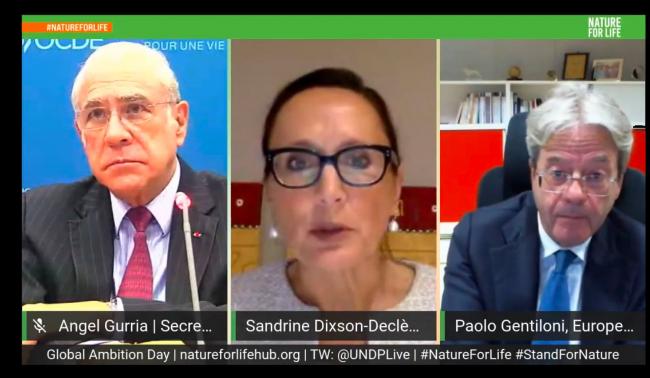Nature for Life: Global Ambition Day
Nature Finance Forum
The Nature Finance Forum convened high-level speakers from governments, philanthropic organizations, Indigenous groups and the private sector, to call for increased financing to meet the post-2020 global biodiversity framework.
Key message included:
- governments must develop policies and de-risk investments to create incentives for the private sector;
- governments alone cannot create change - philanthropists also need to target their efforts;
- businesses must be mobilized to reduce their own carbon footprints and to help establish enabling environments for entrepreneurs; and
- finance is needed for Indigenous stewards and to protect the poorest communities who depend on biodiversity.
Looking at the big picture, Elizabeth Mrema, Executive Secretary, Convention on Biological Diversity (CBD), explained the successful implementation of the post-2020 global biodiversity framework requires USD 500 billion to be redirected from activities that cause harm to biodiversity. Frans Timmermans, Executive Vice-President of the European Commission, called on all leaders to protect 30% of the planet by 2030, explaining the EU plans to do so in its 2030 Biodiversity Strategy, to step up investments.
On opportunities to fund biodiversity, Gerd Müller, Federal Minister of Economic Cooperation and Development, Germany, noted Germany is launching the Legacy Landscapes Fund alongside international environmental organizations to provide long-term finance to the most critical protected areas in developing countries, and invited all to contribute. Sveinung Rotevatn, Minister of Climate and Environment, Norway, underscored the importance of tropical forest restoration, noting a coalition of private companies is willing to pay for those results. Zac Goldsmith, Minister of State for Pacific and the Environment, UK, explained that nature-based solutions could provide one-third of cost-effective solutions needed by 2030, but that presently they attract only 3% of global climate investments.
Speaking about national actions to address biodiversity, Andrea Meza Murillo, Minister of Environment and Energy, Costa Rica, highlighted national action taken to promote biodiversity, including taxing fossil fuels and channelling funds to protected areas, such that forest cover now includes over 52% of land. Jonathan Wilkinson, Canadian Minister of Environment and Climate Change, said Canada is pleased to join the High Ambition Coalition for Nature and People, which supports protecting at least 30% of the world’s land and oceans by 2030.
Representatives from protected areas in Zimbabwe, Patagonia, Indonesia, South Africa, Rwanda and Colombia described how critical finance is to achieving biodiversity goals while simultaneously creating green jobs.
Several speakers from philanthropic organizations called for accelerated financing. Hansjörg Wyss, Wyss Foundation, referencing a USD 1 billion pledge his organization made in 2018 to support locally-driven conservation projects across the globe, said the pace of conservation needs to be accelerated. Melani and Rob Walton, Rob and Melani Walton Foundation, noted that in joining the Legacy Landscapes Fund, they aim to ensure long-term support is provided to conservation. Julie Packard, Packard Foundation, explained businesses, governments and philanthropists need to come together to support the ocean, which covers 70% of the earth and over 99% of the area that can be inhabited by life. Aileen Lee, The Gordon & Betty Moore Foundation, noted that scaling-up multi-donor efforts will deliver more results for ecosystems and the people who depend on them.
On the role of Indigenous peoples, Frank Brown, member of Heiltsuk Nation and Associate Professor at Simon Fraser University, explained that today some of the biggest proposals to protect land are led by Indigenous people in Canada and Australia.
Members of the private sector highlighted their efforts to fund biodiversity. Paul Polman, Imagine, noted that the estimated biodiversity financing gap is USD 600-800 billion, a relatively small investment that needs industry-wide partnerships. He added that Business for Nature has announced 500 companies who are urging governments to adopt policies now to reverse nature loss in this decade. Marc Engel, Unilever, spoke of the company’s Climate and Nature Fund to invest in high impact projects. Anne-Laurence Roucher, Mirova, described her company’s asset management model, whereby public and philanthropic investment in conservation initiatives de-risks and attracts private investment.
Some private sector representatives called for further action. Jeremy Darroch, Sky Group, highlighted the Sky Ocean Ventures Fund, which works with small businesses across the supply chain to find alternative solutions to single-use plastics, and called on businesses to reduce their environmental footprint and assist new entrepreneurs. Antoine Sire, BNP Paribas, highlighted SDG 14 (Life Below Water) and called for a fund to protect coral reefs.
Speaking about the true cost of environmental degradation, Edward Norton, UN Goodwill Ambassador for Biodiversity, called for an authentic price of carbon that reflects mitigation costs, proposing USD 15/ton rather than the current USD 6/ton.
During the closing session, Achim Steiner, Administrator, UN Development Programme, explained that an additional USD 700 billion per year is needed to achieve our biodiversity goals for 2030. Carlos Manuel Rodriguez, CEO, the Global Environment Facility, highlighted four goals that must be achieved to make big progress:
- mobilize financial resources from all sources;
- reduce flow of funds to environmentally damaging areas of the economy;
- pave the way for private investment by changing regulations and policies; and
- recognize that preserving the environment is key to our political and environmental future.
Christiana Figueres, Global Covenant of Mayors, closed the list of speakers by noting that climate change and biodiversity are two sides of the same coin and cannot be addressed separately.
Writer and journalist Touré, the session facilitator, concluded the session by calling for further investments, noting that “we are nothing without planet and the delicate ecology that powers it.”
Leaders Event for Nature & People
This event marked the launch of the Leaders’ Pledge for Nature, developed by the Alliance of Small Island States, Belize, Bhutan, Colombia, Costa Rica, EU, Finland, Kenya, Seychelles and UK, along with inter- and non-governmental partner organizations. Endorsers and supporters of the pledge commit to reversing biodiversity loss by 2030, through 10 specific actions.
At the time of the event, the pledge had attracted endorsements by 70 countries and numerous non-state actors, and hosts expected this number to keep rising. The pledge was launched in support of the first UN Summit on Biodiversity, on 30 September 2020, and the post-2020 biodiversity framework, which countries are expected to agree on at the UN Biodiversity Conference in Kunming, China (CBD COP 15) in 2021.
Opening the event, Volkan Bozkır, President of the UN General Assembly, lamented that none of the Aichi Targets on biodiversity have been fully achieved and expressed hope that the September Summit “elevate the political discourse on biodiversity” and become an important step on the road to Kunming. UN Secretary-General António Guterres called for the new global biodiversity framework to provide a roadmap for implementation. He commended leaders for launching the pledge and called on everyone to make 2021 “nature’s year.” Marco Lambertini, WWF International, called for a carbon-neutral, nature-positive and equitable society, saying there has never been a more crucial time to act for nature and people. David Attenborough reminded world leaders they “can make more of a difference than most.”
Pre-recorded statements by heads of state and government, other government leaders, and leaders of non-state actor groups and organizations, were delivered under two themes: nature and people, and more nature by 2030.
Under the two themes, leaders of the European Commission, Colombia, Kenya, the Marshall Islands, Austria, Bolivia, Seychelles, Pakistan, Hungary, Panama, Peru, Timor-Leste, Monaco, Slovenia, the Czech Republic, UK, Bhutan, Luxembourg, Nepal, Moldova, Sweden, Belize, Finland, France, Germany, Italy and Mexico underscored that:
- There is a need to recognize the interdependence between people and ecosystems. The well-being of vulnerable people in particular needs to be ensured.
- The current market system fails to capture most ecosystem values. Natural capital needs to be restored, and societies must change how they finance, produce and consume.
- Goals related to the pledge include zero biodiversity loss, nature-positive development, carbon neutrality, and resilience.
- Biodiversity conservation is a strategic investment in health, jobs, livelihoods and food security, and protects humanity from diseases.
- Urgent, practical and ambitious actions are needed, including robust goals and strong monitoring mechanisms.
- All parts of governments should engage in implementing the pledge, and concerted action is needed from governments, businesses and civil society.
- Indigenous experience and knowledge should be harnessed, and local communities need to be enlisted to support implementation.
- Time is running out: 2020 is the start of the final decade for all countries to secure the integrated solutions the world needs.
- Economic recoveries from the COVID-19 pandemic should integrate the goal of “saving our life support system.”
- Oceans, the Arctic, wetlands, and forests are among priorities for countries.
Business and civil society leaders, representing Danone, CARE International, FaithInvest, Jupaú Indigenous Association (Brazil), the World Health Organization, CEDENMA (Ecuador), City of Bogotá, financial institutions, Potsdam Institute for Climate Impact Research, Club of Rome and The Nature Conservancy highlighted that:
- Economies and businesses depend on nature.
- Humanity is pushing the planet dangerously close to a tipping point that could result in irreversible destabilization of the system.
- Businesses are ready to support the biodiversity agenda and will continue to engage and raise ambition through various global coalitions. Governments need to create the conditions for the private sector to achieve the biodiversity targets.
- Financial institutions have announced a Finance for Biodiversity Pledge that includes a target of collaborating and sharing knowledge, engaging with companies, setting targets and reporting on them publicly, by 2024.
- 60 major faith traditions will develop “faith long-term plans” to protect nature.
- Equity, justice and women’s rights should be at the heart of efforts to halt biodiversity loss.
- Nature is fundamental for protecting human health.
In a live open leaders’ conversation, moderated by UN Development Programme Administrator Achim Steiner, President of Costa Rica Carlos Alvarado Quesada stressed the need for leaders to keep advocating for the leaders’ pledge worldwide, noting conserving nature pays back in economic growth, jobs and a clean environment. Prime Minister of Canada Justin Trudeau urged everybody, and especially the other top-ten “largest countries in the world,” to commit to biodiversity-related pledges, such as protecting 30% of their territory by 2030.
Prime Minister of Norway Erna Solberg underscored the importance of placing nature-based solutions at the centre of protecting nature, in particular with regard to oceans and tropical deforestation. She said halting tropical deforestation would cost one billion USD per year but these investments provide a positive return on investment. Carlos Manuel Rodriguez, CEO of the Global Environment Facility outlined four actions for achieving the target of protecting 30% of the planet by 2030: protecting nature; restoring degraded ecosystems; “funding nature”; and defunding deforestation.
At the end of the event, a pre-recorded video represented the endorsement ceremony of the pledge by heads of state and government.
Closing the event, CBD Executive Secretary Elizabeth Maruma Mrema called on all stakeholders to come together in global solidarity to take urgent action. UN Environment Programme Executive Director Inger Andersen outlined five areas where transitions are necessary: food systems; resource extraction; energy systems; green infrastructure investments; and land degradation. She called on governments to ensure all post-COVID-19 stimulus packages include “green strings” and reminded that “failure is not an option.”
Creating a Nature-Based Planetary Safety Net
The third session of the day looked back on past successes and failures to protect biodiversity, and ahead to key elements necessary to achieve success in the post-2020 biodiversity framework on local, national and international scales. International graphic facilitator Eleanor Beer illustrated the event, creating an artistic representation of the planetary emergency and a call to action.
Key takeaways included:
- The world is in a planetary emergency where 1 million plant and animal species are at risk of extinction; the world is battling a global pandemic; and climate related disasters are increasing.
- The problems and solutions to today's crises are interlinked, just as they are in the Rio Conventions.
- Women are instrumental to fighting climate change impacts and biodiversity loss.
- While there is a great need for increased ambition, there are many success stories within community initiatives.
- Cities play an important role in increasing biodiversity.
- There is need for ambitious and inclusive action to design the post-2020 biodiversity framework.
Opening the session, Elizabeth Mrema, Executive Secretary, CBD, called for global solidarity to improve biodiversity, including through creating government and business-led enabling environments.
Summarizing key points from the headline-making Intergovernmental Science-Policy Platform on Biodiversity and Ecosystem Services (IPBES) Global Assessment Report published earlier in the year, Ana María Hernández Salgar, Chair, IPBES, noted: services humans receive from nature are rapidly decreasing; none of the 28 biodiversity targets will be achieved by the deadline; and it is not too late if immediate action is taken on the direct causes of biodiversity loss.
Several speakers made calls to action, including Mamphela Ramphele, Club of Rome Planetary Emergency Partnership, who advocated for new lifestyles that are more regenerative and enhance the well-being of people and the planet. Dominic Waughray, World Economic Forum (WEF), called for businesses around the world to look for opportunities and create ambition, and cited WEF’s commitment to reducing greenhouse gas emissions through the Net Zero Challenge.
On the interdependence of the global crises of COVID-19, climate change and biodiversity loss, Karin Kemper, World Bank, explained COVID-19 threatens to reverse development gains made in recent years, and added sustainability, inclusion and resilience must be at the core of recovery plans. Several speakers called for increased action to simultaneously tackle all environmental issues together, and many pointed to existing cost-effective solutions.
On the role of women, Minna Salami, Afropolitan Blog, explained feminism is a necessary force in the climate crisis noting that diverse women’s voices must be included in the discussions.
Past CBD Conference of the Parties (COP) Presidents from Japan, India, South Korea, Mexico and Egypt spoke of achievements, and highlighted the need to work across governments and international conventions, mobilize resources, and transition to a decarbonized economy. Looking ahead, the current CBD COP President Huang Runqiu called for ambitious, realistic and balanced targets to catalyze action.
On success stories, a video presentation from the CBD highlighted the 2010 biodiversity goals to protect 17% of the Earth’s land and 10% of oceans will be reached by adding terrestrial and marine conservation areas in Morocco, Niue, India, French Polynesia, Samoa, the UK, Łutsel Kʼe community in Canada, Fiji, Kazakhstan, the Alianza Ceibo community in Ecuador, Seychelles, Bhutan, and Algeria.
Zac Goldsmith, Minister of State for Pacific and the Environment, UK, spoke of a new GBP 500-million Blue Planet Fund to help official development assistance eligible countries protect their marine environments from human generated threats. Marina Von Weissenberg, Ministry of the Environment, Finland, explained that Finland has been conducting scientific assessments on the effectiveness of CBD implementation since 1995.
A video captured efforts made by communities on the ground, including carbon capture initiatives amongst farmers in South Africa, the conservation of Thaidene Nëné an ancestral territory of the Łutsel Kʼe First Nation in Canada, Utz Che’ in Guatemala incorporating indigenous knowledge to protect local forests, and a sustainable cosmetic initiative in Mexico called Mujeres y Ambiente.
In a panel discussion on national efforts, Per Olsson Fridh, State Secretary to the Minister for International Development Cooperation, Sweden, and Krista Mikkonen, Minister of Environment, Finland, took part in a brief panel on how countries are achieving biodiversity targets. Olsson Fridh highlighted Sweden’s 250% increase in biodiversity funding in the last decade, and called for further reprogramming of existing funding to have biodiversity links.
On the role of cities, Valérie Plante, Mayor of Montreal, noted that actions taken by cities have a global impact, and they have the opportunity to reallocate budgets to invest in green and blue infrastructure.
Moving from the local-scale to the big picture, Patricia Espinosa, Executive Secretary, UN Framework Convention on Climate Change, explained the planetary safety net must be woven to be strong sustainable and healthy, adding the three Rio Conventions must work together to protect these nets. Svenja Schulze, Minister, Federal Ministry for the Environment, Nature Conservation and Nuclear Safety, Germany, explained how the pandemic was a reminder that biodiversity protects us from diseases and provides us with livelihoods, food and water. She called for a new biodiversity framework that aligns capital flows and investments with nature, sending a strong message to the financial world.
During a panel discussion on further actions needed to achieve biodiversity goals, Peter Thomson, UN Secretary-General Special Envoy for the Ocean, Alice Ruhweza, World Wide Fund for Nature, and Carlos Manuel Rodriguez, CEO and Chairperson, the GEF, called for a blue-green recovery approach, engaging citizens, and good governance.
In a video, youth spoke out against greenwashing and warned against separating local communities from nature.
In a last panel discussion on transformative change, Rebecca Moore, Google Earth, called on the UN to embrace innovative data sources, and Remy Rioux, French Development Agency, noted the Agency has committed 30% of its climate finance to be nature-based.
Green Recovery and Green New Deals
This session examined what governments and other stakeholders are doing to ensure that post-COVID-19 economic recoveries and related stimulus packages are green, resilient and inclusive. It also identified related shortcomings and tangible actions still needed to achieve the needed transformations, including through policies, action by multiple stakeholders and finance.
Central messages highlighted by participants include:
- Protecting nature equals protecting the economy: natural capital and environmental services need to be costed. This helps build the business case for nature-based interventions.
- Public policies need to stop environmental damage. Governments must stop subsidizing fossil fuels and put a high price on emissions to promote behavioural change.
- Debt for nature and debt for climate swaps are timely sovereign instruments that can reduce the costs of capital for developing countries in exchange for improved environmental performance.
- Cities, municipalities and businesses also need to be involved in the recovery. Some have more ambitious targets than national governments.
- With COVID-19, resilience is now a priority to people who have supply chain concerns. Related innovative solutions include risk management plans for the planetary emergency and national risk registers.
On policy priorities to enable green, resilient and inclusive recoveries, Ángel Gurría, Secretary-General, Organisation for Economic Co-operation and Development, outlined: mainstreaming biodiversity through ex-ante screening and ex-post monitoring of policies; scaling down support that is harmful to biodiversity and scaling up positive incentives; and harnessing the potential of the private sector and finance.
On targets and initiatives put forward by the European Commission, Paolo Gentiloni, European Commissioner for Economy, listed: the European Green Deal, which proposes to unlock one trillion Euros in sustainable investments; a carbon neutrality target for 2050; a 30% requirement for spending in climate change and green flagship programmes; green bonds; a carbon border adjustment mechanism; and the Just Transition Mechanism.
On measures already taken by governments, Krista Mikkonen, Minister of the Environment and Climate Change, Finland, highlighted: an advisory group for sustainable recovery that has delivered recommendations; and EUR 1.5 billion invested in sustainable recovery measures, including renewable energy subsidies, rail infrastructure and electric vehicle infrastructure. Mohammad Mahmood Abubakar, Minister of State for Environment, Nigeria, said his government has engaged Indigenous people in forest conservation-related activities and plans to invest in five million solar home systems. Rosanna Cunningham, Cabinet Secretary for Environment, Climate Change, and Land Reform, Scotland, highlighted funding to support the decarbonization of homes.
On the importance of simultaneously addressing the “inequality crisis,” Oliver Greenfield, Green Economy Coalition, underscored that people need to be given a stake in decisions to drive change. He suggested countries establish “citizens’ recovery assemblies” and articulate a new commitment that no one will be left behind to reinvigorate trust in policymakers. Anuela Ristani, City of Tirana, stressed the need to ensure all actions are inclusive and involve all citizens.
On what is still needed to enable the transition to green economies, Andrea Meza Murillo, Minister of Environment and Energy, Costa Rica, called for policy coherence, whole-of-government and whole-of-society approaches, policy instruments for incentivizing private sector participation, and greening the financial sector. Simon Stiell, Minister for Climate Resilience, Environment, Forestry, Fisheries, and Disaster Management, Grenada, observed that development agencies verbally support green recoveries, but stimulus investments so far have not supported low-carbon transitions.
On critical areas to focus in relation to finance, Simon Zadek, Finance for Biodiversity, identified stimulus funding and sovereign debt restructuring as two “multi-trillion flows” that are shaping the global economy as it emerges from the pandemic. He lamented that the G20 countries’ stimulus programmes have net-negative environmental impacts and called for simultaneously solving the sovereign debt crisis and the nature crisis. He noted that “a dozen individuals can change the footprint of this global stimulus programme and bring nature to the core of the sovereign debt restructuring coming out of this pandemic.”
Concluding the event, moderator Sandrine Dixson-Declève, Club of Rome, noted that most stimulus packages still support a return to business-as-usual although the majority of citizens, as long as their livelihoods are protected, would not prefer this. She observed that many leaders, however, are placing nature and decarbonization at the core of recoveries and stressed that now “is the time to create the economies we need post-COVID-19.”
Mapping Nature for People and Planet: The Big Enchilada
This session demonstrated how innovative use of new spatial datasets can provide the tools to place nature at the heart of sustainable development.
On the importance of and opportunities for mapping natural landscapes, Carlos Manuel Rodriguez, the Global Environment Facility, explained that current data is needed to make national policy on biodiversity. Rebecca Moore, Google Earth, announced the launch of Dynamic World, created in partnership with National Geographic and the World Resources institute, which produces up-to-date open access maps of land cover to help countries track targets to manage and restore ecosystems. Thomas Lovejoy, UN Foundation, noted that up-to-date maps are necessary to respond in real time and watch for tipping points.
Highlighting innovations in mapping, the Global Safety Net (GSN1) presented how it maps a network of land areas vital for nature and humanity, generating the first comprehensive estimate of the total area required to address biodiversity loss and climate change.
Discussing the cost-benefit analysis of protecting 30% of the planet by 2030, Duko Hopman, Mckinsey & Company, presented the company’s report, Valuing Nature Conservation. He underscored the need for such reports, saying the business case for nature exploitation is typically more compelling than conservation, and noted the report found protecting the planet could support 30 million jobs and generate USD 500 billion in GDP.
In focusing on national case studies of essential life support areas, Andrea Meza, Minister of Environment and Energy, Costa Rica, and Rafael Monge, National Center for Geo-environmental Information, presented on the case of Costa Rica, explaining 'The Big Enchilada' combines key ingredients (national and global spatial data) and uses an innovative recipe (cutting-edge scientific methods) to create a map of hope. He noted that mapping has overcome sectoral boundaries to improve the management of its ecosystems. Tom Okurut and Francis Ogwal, National Environment and Management Authority, Uganda, spoke about the creation of a “map of hope” in Uganda, which charts the course for nature-based solutions in the country. Hernando Garcia, Humboldt Institute, underscored that water is life in Colombia, and Florez Espinosa, RAP-E Colombia Administrative Unit, added data is used to map river and waterbeds, and determine who uses water and how much.
Yakup Beris, UNDP Kazakhstan, shared on the development of a “map of hope” to reveal where Kazakhstan can reduce environmental degradation and support food security. Gabriel Quijandría Costa, Ministry of Environment, Peru, described his country’s “map of hope,” which he said is based on diverse data, knowledge and needs, including of Indigenous peoples and youth.
On spatial data tools, Steven Brumby, National Geographic Society, presented on Dynamic World, which seeks to provide a dynamic map for decision makers on “what and where to restore and manage” and was developed by teaching computers to “help us see the world in new ways and on scales.” Enric Sala, National Geographic Society, described new data that allows for dispelling the myth that marine protection conflicts with fishing interests by helping define the “right 30%” of the ocean that, if protected, will deliver benefits for biodiversity, food security and climate change mitigation.
Andrew Plumptre, Key Biodiversity Areas Secretariat, presented on a database of 16,000 key biodiversity area sites that enables stakeholders, among other things, to identify and assess these areas at the national level. Andrew Hansen, Montana State University, presented on the NASA Forest Integrity Project, which used satellite data to identify the best high-quality tropical forests and piloted frameworks for action in 21 countries. Guido Schmidt-Traub, Sustainable Development Solutions Network, announced the launch of Nature Map, which seeks to increase access to spatial data and reduce fragmentation, supporting both global and national applications.
The UN Environment Programme – World Conservation Monitoring Centre, presented on various initiatives, including the World Database on Protected area, which is the global reference of data on protected areas. Janet Ranganathan, World Resources Institute, demonstrated how the Resource Watch enables developing multi-layered national-level land maps to support policymaking.
Jeffrey Parrish, The Nature Conservancy, announced the organization will make its spatial data and maps available to support protecting 30% of the earth’s biodiversity by 2030. Jamison Ervin, UNDP, explained how the UN Biodiversity Lab helps decision-makers “go from data to insight to decision” and how the UNDP is pioneering a process that enables decision-makers to map “essential life support areas” by combining various layers of data.
In a panel discussion on how businesses, indigenous communities and non-governmental organizations are using spatial data to support sustainable development, Giulia Stellari, Unilever, highlighted how her company has used geospatial and earth observations data and geolocation tracking to gain transparency into the first mile of first suppliers and sourcing locations. Rachel Barré, L’Oréal, explained how direct access to data from the field has enabled independent assessments and mitigation of risks for the company.
Giovanni Reyes, ICCA Consortium in the Philippines, shared on work to merge mapping of landscapes with spiritual and cultural value interpretations of landscapes to define Indigenous peoples’ relationships to their land and use this knowledge for nature-based interventions. Johnson Cerda, Conservation International, stressed the need to provide data tools for communities and build communities’ capacity to expand community engagement.
Regarding how spatial data can transform their work in the next decade, panelists suggested: access to data that includes community perspectives and social dimensions; unprecedented collaboration to engage all stakeholders to tackle nature loss; Indigenous peoples having reclaimed their lands; and integration of knowledge from communities.
